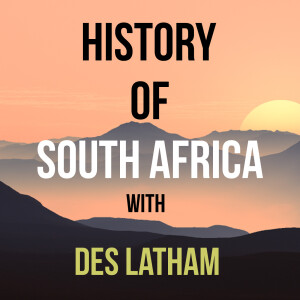
History of South Africa podcast
History

Episode 8 - The San art of the Apocalypse, a Dutch maritime revolution and Sir Francis Drake lauds the ‘fairest Cape’
 2021-04-04
2021-04-04
Download
Right click and do "save link as"
So by the early 1500s Portugal controlled the major ports along northern Mozambique and into modern day Kenya all the way up to Mombasa. However, they did not seek to take over the land so to speak – at least at first. The idea was to build fortified ports so that they could enhance trade with those inland without resorting to boots on the ground.
At the same time, Great Zimbabwe had passed into history and the western parts of Zimbabwe were now controlling the trade routes between Southern Africa and the Indian ocean ports.
Meanwhile to the south, Sotho and Tswana speakers had pushed into the mixed Bushveld habitats that lie against the grasslands of the Highveld.
At this time, dry stone walling starts to be used to mark essential settlement boundaries, reaching the southern shores of the Vaal river and the Free State by the early 1600s.
Oral history has helped us a great deal as the Sotho and Tswana storytelling means we know that the people who moved here came from Botswana of today, and founded a core Tswana identity in the areas of present-day Rustenburg and Marico by the late 1400s.
There is an elaborate Tswana creation myth involving a leader called Matsieng who is said to have emerged from holes in the earth. This is now believed to be related to the origin of the Tswana northeast of capital of Botswana Gaborone where there are rock cavities and sumps in the riverbeds.
Once again Geology and landscape plays its part in our history.
Meanwhile, the last year of the fifteenth and through the sixteenth century, South Africa’s contacts with the outside world took on new forms.
view more
At the same time, Great Zimbabwe had passed into history and the western parts of Zimbabwe were now controlling the trade routes between Southern Africa and the Indian ocean ports.
Meanwhile to the south, Sotho and Tswana speakers had pushed into the mixed Bushveld habitats that lie against the grasslands of the Highveld.
At this time, dry stone walling starts to be used to mark essential settlement boundaries, reaching the southern shores of the Vaal river and the Free State by the early 1600s.
Oral history has helped us a great deal as the Sotho and Tswana storytelling means we know that the people who moved here came from Botswana of today, and founded a core Tswana identity in the areas of present-day Rustenburg and Marico by the late 1400s.
There is an elaborate Tswana creation myth involving a leader called Matsieng who is said to have emerged from holes in the earth. This is now believed to be related to the origin of the Tswana northeast of capital of Botswana Gaborone where there are rock cavities and sumps in the riverbeds.
Once again Geology and landscape plays its part in our history.
Meanwhile, the last year of the fifteenth and through the sixteenth century, South Africa’s contacts with the outside world took on new forms.
More Episodes
012345678910111213141516171819
Create your
podcast in
minutes
- Full-featured podcast site
- Unlimited storage and bandwidth
- Comprehensive podcast stats
- Distribute to Apple Podcasts, Spotify, and more
- Make money with your podcast
It is Free
- Privacy Policy
- Cookie Policy
- Terms of Use
- Consent Preferences
- Copyright © 2015-2024 Podbean.com





